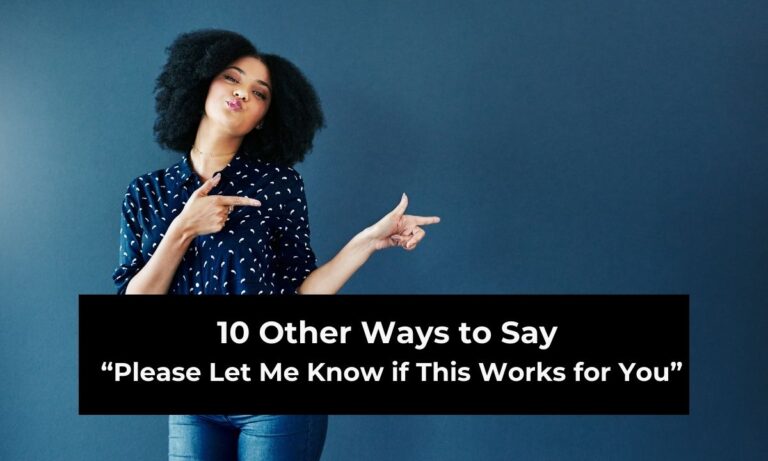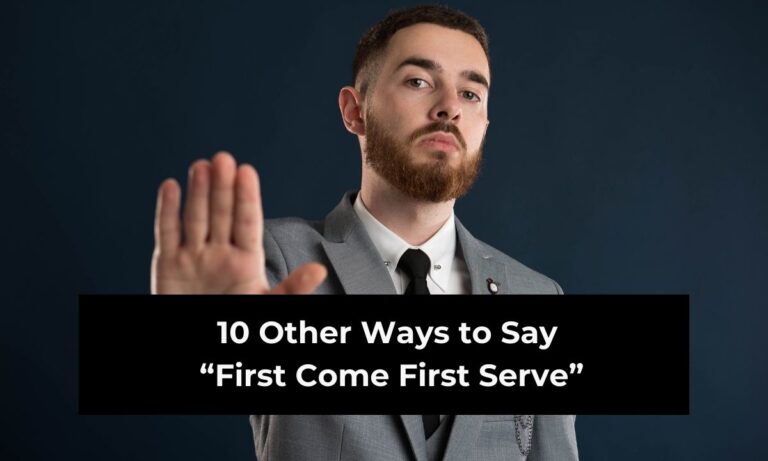Have you ever found yourself replying with the same old phrase, “That works for me,” whenever someone suggests a plan, idea, or schedule? While it gets the point across, using the same phrase repeatedly can sometimes feel dull or even robotic. Words are powerful, and the way you respond shapes the tone of your conversations—whether it’s with friends, colleagues, or clients.
When you switch up your language, you come across as more approachable, flexible, and engaging. Imagine how much more natural it feels to say, “Sounds like a plan” instead of the repetitive “That works for me.” The shift is small, but it makes your communication feel warmer and more personal.
This is especially important in professional settings. If you’re constantly agreeing to meetings or project timelines with the same line, your tone may come across as uninspired. On the other hand, having a variety of responses ready allows you to express agreement while also showing your personality, enthusiasm, or level of commitment.

Even in casual situations—like making weekend plans with friends—variety in your language can help strengthen your relationships. It shows you’re paying attention, you’re interested, and you’re genuinely on board with what’s being discussed.
That’s why in this article, we’re going to explore 12 other ways to say “That works for me.” Each option is explained in detail, with examples and guidance on when to use them. By the time you finish reading, you’ll have a full toolkit of phrases to make your conversations feel more vibrant and authentic.
1. “Sounds Good to Me”
This is one of the most versatile alternatives you can use in both casual and professional settings. It conveys agreement without sounding too formal or rigid.
When a friend suggests grabbing dinner at a new restaurant, replying with “Sounds good to me” communicates that you’re open and agreeable. It’s friendly and conversational, making the other person feel comfortable.
In a workplace context, this phrase works well in email replies or meetings. For example, if a colleague says, “Let’s meet at 3 PM tomorrow,” your response could be, “Sounds good to me.” It’s professional while still being approachable, which makes it perfect for everyday communication.
This phrase strikes a balance between enthusiasm and practicality. It doesn’t overcommit, but it still shows you’re on board. If you want to soften your tone and keep things light, “Sounds good to me” is a reliable choice.
2. “I’m On Board”
When you say “I’m on board,” you’re doing more than agreeing—you’re signaling active participation. This phrase is great for situations where you want to express enthusiasm about joining in.
For instance, if your team proposes a new project idea, saying “I’m on board” shows you’re not only agreeing but also ready to contribute. It communicates positivity and a willingness to collaborate, making it especially effective in professional conversations.
In personal contexts, the phrase has a supportive feel. If a friend suggests a new fitness challenge, replying with “I’m on board” highlights your excitement and commitment to join in. It feels like you’re part of a team, working toward a shared goal.
Use this phrase when you want to sound motivated, supportive, and engaged. It’s perfect for moments where agreement means more than just passive acceptance.
3. “Let’s Do It”
If you want to add a little energy to your response, “Let’s do it” is the way to go. It’s short, enthusiastic, and gives the impression that you’re ready to take action.
Picture a friend suggesting, “Let’s head out for a hike tomorrow.” Instead of replying with “That works for me,” you could say, “Let’s do it!” Suddenly, the plan feels more exciting and dynamic.
In professional settings, you can use this phrase to show motivation during brainstorming sessions or team planning. For example, if a manager suggests trying a new strategy, responding with “Let’s do it” communicates your readiness to move forward.
It’s a phrase that carries enthusiasm and commitment. Use it when you want to go beyond agreement and create momentum in the conversation.
4. “I’m Okay with That”
Sometimes, you want to keep your response neutral without sounding uncooperative. “I’m okay with that” is a good alternative in such situations.
It works especially well in discussions where you might not have strong feelings about the decision but still want to agree politely. For example, if a group decides to watch a certain movie, and you’re fine with the choice, you can say, “I’m okay with that.”
In the workplace, this phrase can soften agreement without sounding overly enthusiastic. If your manager asks if a deadline works, “I’m okay with that” shows acceptance while keeping expectations realistic.
This phrase is flexible and works best when you want to maintain balance between professionalism and friendliness.
5. “That’s Fine with Me”
This is another neutral yet polite option. “That’s fine with me” communicates agreement while leaving space for others’ preferences.
For example, if your colleague says, “How about we start the meeting an hour later?” you could respond with, “That’s fine with me.” It shows you’re accommodating without sounding dismissive.
In casual contexts, this phrase works well when you’re comfortable going along with someone else’s suggestion. If friends want to change dinner plans last minute, responding with “That’s fine with me” makes you sound easygoing.
Use this when you want to sound agreeable but still neutral. It keeps things flexible while maintaining clarity.
6. “That’s Perfect”
When you want to show excitement and appreciation, “That’s perfect” is the ideal choice. It communicates that not only does the plan work, but it’s actually the best option for you.
For instance, if a client suggests a meeting time that fits your schedule exactly, you could say, “That’s perfect.” It leaves a positive impression because it makes the other person feel like they’ve met your needs seamlessly.
In personal settings, this phrase can make plans feel more solid. If a friend suggests your favorite restaurant for dinner, “That’s perfect” conveys your happiness and approval.
This phrase is best used when the suggestion truly suits your needs. It’s genuine and uplifting, and it makes conversations more pleasant.
7. “Absolutely”
Sometimes, a single word is all you need. “Absolutely” is powerful because it communicates certainty and enthusiasm.
If someone asks, “Does this time work for you?” replying with “Absolutely” instantly makes you sound confident and positive. It’s short, but it packs a lot of impact.
In professional situations, this word works well when you want to emphasize agreement quickly. During team meetings, saying “Absolutely” after an idea reinforces your support without taking up much time.
Use this when you want to sound enthusiastic, supportive, and 100% confident in your agreement.
8. “I’m In”
This phrase is casual and fun, perfect for social plans and informal conversations. “I’m in” gives the impression that you’re excited and ready to be part of whatever is being planned.
For example, if your friends are planning a road trip, saying “I’m in” shows excitement and eagerness to join. It makes you sound approachable and adventurous.
In professional contexts, it can also work during brainstorming or team projects. Saying “I’m in” communicates that you’re committed and ready to participate.
This phrase has an energetic tone, making it great for conversations where you want to express genuine interest.
9. “That’s a Great Idea”
Sometimes, you want to do more than agree—you want to compliment the suggestion. Saying “That’s a great idea” adds positivity to your response.
In casual situations, this phrase works perfectly when a friend suggests something creative or fun. Instead of simply saying it works, you’re showing appreciation for their input.
In professional settings, it can help build rapport. For instance, if a colleague proposes a new process, saying “That’s a great idea” validates their contribution while agreeing to move forward.
This phrase is especially powerful in team environments, where recognition can boost collaboration and morale.
10. “That Works Perfectly”
If you want to emphasize that the timing or suggestion is not just acceptable but ideal, use “That works perfectly.”
For example, if someone schedules a meeting at a time that matches your availability, replying with “That works perfectly” highlights that it’s the best option.
In personal conversations, it’s a polite way of showing appreciation. If a friend offers to pick you up on their way, saying “That works perfectly” communicates gratitude and agreement.
It’s best used when the arrangement is genuinely convenient for you. This phrase makes the other person feel like they’ve chosen well.
11. “I Can Work with That”
This phrase is useful in situations where the option isn’t your first choice, but you’re still willing to go along with it. It communicates flexibility while maintaining honesty.
For instance, if your team suggests a deadline that’s tight but manageable, you might say, “I can work with that.” It shows cooperation without pretending the situation is flawless.
In casual contexts, it works when plans aren’t perfect, but you’re willing to adjust. If friends want to eat at a place that’s not your favorite, “I can work with that” is a polite and accommodating response.
This phrase is practical and realistic, perfect for showing adaptability.
12. “That Should Work”
This option strikes a middle ground between certainty and flexibility. “That should work” implies you’re confident about the plan but leaving space for adjustments if necessary.
In professional communication, this phrase can be helpful when scheduling. If someone suggests a meeting time, replying with “That should work” shows you agree, but you’re keeping the door open in case conflicts arise.
In casual settings, it works well when plans aren’t fully confirmed. For example, if someone says, “Let’s meet at 7, unless traffic is bad,” you might respond with, “That should work.”
This phrase is polite, practical, and adaptable to different contexts.
Conclusion
Language shapes how others perceive you, and even small changes can make a big difference. Instead of relying on the same old “That works for me,” you now have a dozen fresh ways to express agreement. Some are light and casual, like “I’m in” or “Let’s do it,” while others are professional and polished, like “That’s perfect” or “Absolutely.”
Using these alternatives not only makes you sound more dynamic but also helps you connect better with others. In professional conversations, they highlight your enthusiasm, adaptability, and supportiveness. In personal situations, they make you sound approachable, warm, and engaged.
The key is to match the phrase to the context. If you’re in a business meeting, you might go with “I’m on board.” If you’re planning something with friends, “Sounds good to me” could be a better fit. By choosing the right words, you’re not just agreeing—you’re shaping the flow of the conversation and making it more enjoyable for everyone.
Next time someone suggests an idea, schedule, or plan, try one of these 12 alternatives. You’ll notice how much more engaging and natural your conversations feel.
FAQs
1. Why should I avoid saying “That works for me” too often?
Because repetition can make you sound robotic. Varying your language keeps conversations engaging and shows your personality.
2. Which alternative is best for professional settings?
Phrases like “That’s perfect,” “I’m on board,” and “Absolutely” work best in professional contexts because they sound confident and polished.
3. Can I use casual phrases in the workplace?
Yes, but use them wisely. Informal phrases like “I’m in” or “Let’s do it” work in team settings but may not be suitable for formal client communication.
4. How do I choose the right phrase for the situation?
Think about tone. Use enthusiastic phrases for casual settings and more polished options for professional conversations.
5. Do these alternatives work in written communication too?
Absolutely. You can use many of these phrases in emails, messages, or chat platforms to keep your communication fresh and engaging.





